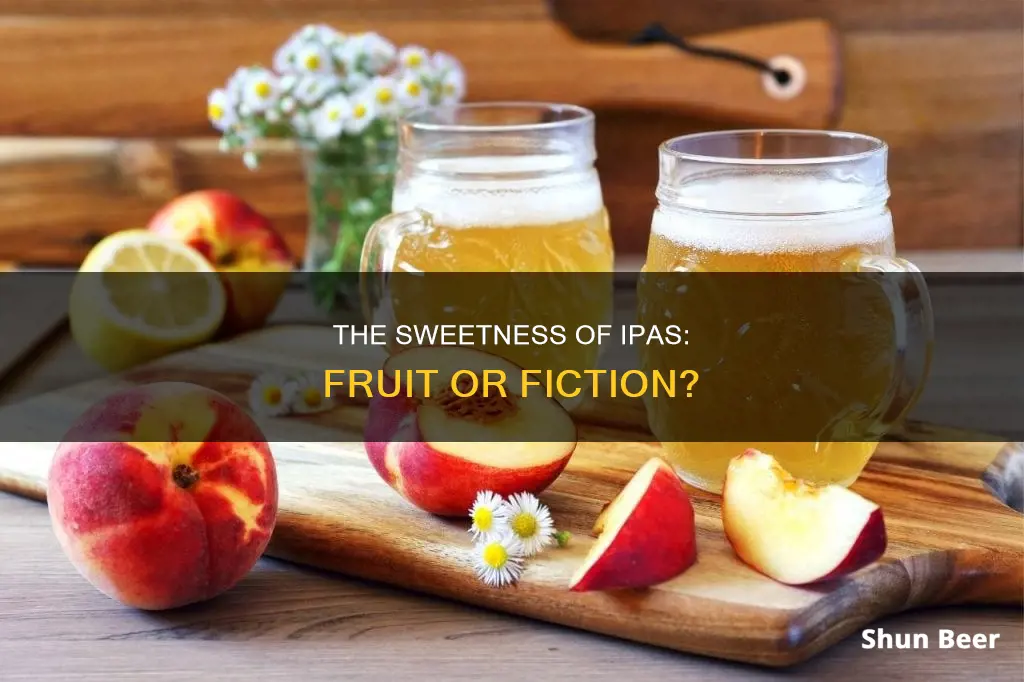
India Pale Ales (IPAs) are a broad style of beer that comes in a range of varieties. While IPAs are often associated with bitterness, the modern approach to hoppy beer involves exploring the world of fruity flavours that can be derived from hops. Fruit flavours can be added to IPAs through various methods, including the use of fresh fruit, puréed fruit, fruit juice or pulp. Some IPAs are dry-hopped, which means the hops are steeped in the fermenting beer rather than added during boiling, resulting in a stronger aroma without added bitterness. Additionally, certain IPAs, such as the West Coast IPA, are known for their tropical fruit notes, while the New England IPA is unfiltered and has extremely low bitterness with intense, fruity flavours.
What You'll Learn
- Fruit IPAs can be made with fresh fruit, puréed fruit, fruit juice, pulp or concentrate
- Fruity IPAs are often dry-hopped, which amplifies the fruity notes without adding bitterness
- Fruit IPAs can be made with hops that have intense, fruity flavours, such as Citra hops
- Fruit IPAs can be made with a combination of hops and fruit purée, which adds flavour without taking shortcuts
- Fruit IPAs can be hazy, like the New England style, which has low bitterness and intense, fruity flavours

Fruit IPAs can be made with fresh fruit, puréed fruit, fruit juice, pulp or concentrate
Fruit IPAs are a unique style of beer that combines the bitterness and hoppy character of IPAs with the sweetness and freshness of fruits. The process of brewing a fruit IPA is not much different from brewing any other fruit beer, and brewers have a lot of flexibility in terms of the ingredients they use and the techniques they employ.
Fruit IPAs can be made with a variety of fruits, and the most popular options include citrus fruits like grapefruit and blood orange, as well as tropical fruits like mango and pineapple. The choice of fruit depends on the desired flavour profile and intensity. Brewers can use fresh fruit, puréed fruit, fruit juice, pulp, or concentrate to infuse their IPAs with fruity goodness.
When using fresh fruit, it is important to pasteurize it to eliminate any unwanted yeasts or bacteria that may interfere with the brewing process. This can be done by heating the mashed fruit to around 170ºF (77ºC) for a few minutes. Frozen fruit can also be used, and it has the added benefit of rupturing cell walls, allowing for a faster release of flavours. However, it is crucial to thaw frozen fruit before adding it to the fermenter to avoid shocking the yeast.
Fruit purée is another popular option as it offers a convenient way to add fruit flavour without the need for pasteurization. Purées can be added directly to the primary or secondary fermenter, depending on the brewer's preference. Some brewers opt to add purée towards the end of the initial fermentation in the primary fermenter, while others choose to rack the beer onto the purée in the secondary fermenter.
Fruit juices, pulps, and concentrates can also be used to impart flavour to IPAs. Citrus peels, for example, can be added during the final minutes of the boil to release their oils and add a subtle bitterness. Fruit juices should be carefully selected to avoid overly acidic flavours that may make the beer unpleasant to drink.
The amount of fruit used will depend on the desired intensity of flavour and the type of fruit. Generally, strongly flavoured fruits like raspberries require less quantity (around 1 lb. per gallon) compared to milder fruits like cherries (about 2 lb. per gallon).
Brewers have the freedom to experiment with different fruits, quantities, and techniques to create unique and delicious fruit IPAs that showcase the best of both worlds—the bitterness of IPAs and the sweetness of fruits.
The Evolution of the Guinness Beer Logo
You may want to see also

Fruity IPAs are often dry-hopped, which amplifies the fruity notes without adding bitterness
India Pale Ales (IPAs) are known for their fruity notes. While some IPAs are brewed with fresh fruit, puréed fruit, fruit juice, pulp, or concentrate, others get their fruity notes from the hops themselves. Hops are one of the most aromatically complex botanicals, with hundreds of different compounds responsible for their attractive bouquet.
Some popular fruity IPAs include:
- Boulevard Brewing Co. Pop-Up Session IPA
- Samuel Adams / Boston Beer Company Rebel Rider IPA
- AleSmith Brewing Co IPA
- Brooklyn Brewery Pulp Art
- Lord Hobo 617 Hazy IPA
- Two Roads Brewing Company Lil Heaven Session IPA
- Ghostfish Brewing Company It Came from the Haze
Guinness Beer: Unveiling the Secret of Its Strength
You may want to see also

Fruit IPAs can be made with hops that have intense, fruity flavours, such as Citra hops
Fruit IPAs are India Pale Ales with fresh fruit, puréed fruit, fruit juice, or fruit pulp added. The most popular fruit IPAs use fruits that either accentuate the citrus character of their hops (such as grapefruit or blood orange) or the tropical character in hops (such as mango or pineapple). Fruit IPAs can also be made with hops that have intense, fruity flavours, such as Citra hops.
Citra hops are a popular choice for American-style beers, providing a strong citrus aroma to your brew. The Citra hops profile also includes peach, apricot, passion fruit, lemon, melon, and other tropical fruit flavours and aromas. Citra hops are noted for their higher Geraniol content, which is biotransformed by yeast into Citronellol, a highly-sought-after aroma compound in fruit-forward IPAs.
When brewing a fruit IPA, the type and amount of fruit added will depend on the desired intensity of the fruit flavour. For example, for strongly flavoured fruits like raspberries, it is recommended to use 1.0 lb. of fruit per gallon, while for milder fruits like cherries, you would use 2.0 lb. per gallon. Similarly, adding citrus zest will impart more flavour and aroma than just using the fruit peel or flesh.
Brewers can also experiment with different types of hops to achieve the desired fruit character in their IPAs. For example, Falconer's Flight hops have a tropical fruit character that pairs well with mango or other tropical fruits, while Mosaic hops have notes of blueberry, tangerine, and papaya.
Ultimately, the key to a successful fruit IPA is finding the right balance between the fruit and the underlying beer flavours, ensuring that the fruit enhances the beer without overwhelming it.
Customizing Your IPA Beer Kit: Spicing Up Your Brew
You may want to see also

Fruit IPAs can be made with a combination of hops and fruit purée, which adds flavour without taking shortcuts
Fruit IPAs are made with a combination of hops and fruit purée, which adds flavour without taking shortcuts. The most popular fruit IPAs use fruits that either accentuate the citrus character of their hops (such as grapefruit or blood orange) or the tropical character of their hops (such as mango or pineapple). The fruit can be added as the peel, in the case of grapefruit or other citrus fruits, or as the flesh, or both. Brewers can use fresh fruit, fruit purée, or 100% fruit juice.
Citrus peels should be added in the final few minutes of the boil, as they will add oils from the outer peel and potentially some bitterness if much white pith is added with them. Adding citrus zest will not affect the original gravity (OG) or final gravity (FG) of the beer. Fruit flesh, whether from whole fruits, purées, or fruit juice, can be added in the secondary. The usual rule when brewing fruit beers is to use 1.0 lb. of fruit per gallon (110 g/L) for strongly flavoured fruits (such as raspberries) and 2.0 lb. per gallon (220 g/L) for milder fruits (such as cherries). In the case of tropical fruit IPAs, such as a mango IPA, around 1.0 lb. per gallon should give a reasonable amount of flavour.
Fruit will add some sugar to the fermenting beer, but it will only add simple sugars such as glucose, sucrose and fructose, which are 100% fermentable. Therefore, it will not affect the FG (or body) of the beer, but it will boost the “virtual OG” by a few points. Brewers should let the beer ferment the fruit sugars and contact the fruit for 7–10 days, then rack away from any fruit sediment to the keg or bottling bucket.
The most abundant acids in most citrus and tropical fruits are citric acid and malic acid. When adding citrus fruit pulp or juice, or other strongly acidic fruits, brewers should keep in mind that too much acidity may make the beer unpleasant to drink. For citrus-accented IPAs, most of the added fruit character should come from zest.
Double IPAs: Sour or Not?
You may want to see also

Fruit IPAs can be hazy, like the New England style, which has low bitterness and intense, fruity flavours
Fruit IPAs are a unique style of beer that has gained popularity in the craft beer world. These beers are characterised by their intense fruit flavours, which can range from tropical fruits like mango, passion fruit and pineapple to citrus fruits like grapefruit, orange and tangerine. They may also feature notes of berry, stone fruit or even dark fruits. While IPAs are typically associated with bitterness, Fruit IPAs tend to have lower bitterness and a softer, smoother mouthfeel.
The haze in Fruit IPAs is often a result of the brewing process, which may involve the use of grains with higher protein content, such as oats and wheat. This natural haze gives the beer a cloudy or opaque appearance. Additionally, the late addition of hops during the whirlpool stage or after fermentation through dry hopping can enhance the haze and unlock aromatic compounds, contributing to the intense fruit flavours.
The New England IPA (NEIPA) is a style of Fruit IPA that originated in the New England region of the US. These beers are known for their hazy or cloudy appearance, low bitterness and intense fruity flavours. The term "Hazy IPA" is often used interchangeably with "New England IPA," but not all hazy IPAs are necessarily brewed in the New England style. The haze in NEIPAs is not just about appearance but also enhances the mouthfeel and aroma of the beer.
NEIPAs are heavily hopped with New World hop varieties like Citra, Mosaic and Sabro, which are known for their tropical fruit qualities. The emphasis on late hopping and dry hopping in this style intensifies the "juicy" character. While the appearance of NEIPAs can vary from translucent to opaque, it is the mouthfeel and aroma that define this style. The higher protein content from grains contributes to a softer, silkier mouthfeel, making these beers extremely approachable even for those who typically shy away from bitter IPAs.
The popularity of NEIPAs and hazy IPAs has spread across the country, with many breweries outside of New England adopting this style. The success of these beers lies in their ability to showcase an abundance of hops, providing intense fruit flavours and aromas while keeping bitterness in check. The haze and fruit-forward profile of these beers have broadened the appeal of IPAs, introducing new ideas about what beer can be and attracting a wider range of drinkers.
Guinness Beer Food Pairing: Delicious Eats to Enjoy
You may want to see also
Frequently asked questions
IPA stands for India Pale Ale. The beer was invented in Britain when British sailors loaded up barrels of beer with hops to preserve them on their voyage to India.
No, not all IPAs are bitter. While the British IPAs are known for their malty, bitter taste, the West Coast IPA style, for example, explores the world of fruity flavors while retaining some bitterness.
Double and Imperial IPAs are essentially the same thing. They have a higher hop concentration and more malt to balance the flavor, resulting in a higher ABV (usually over 7%).
Dry-hopping is the process of steeping hops in fermenting beer rather than adding them during the boiling process. This amplifies the fruity, piney, or candy-sweet notes without adding any bitterness.
Fruit IPAs are brewed with fresh fruit, puréed fruit, fruit juice/pulp/concentrate, or fruit flavors derived from hops.







